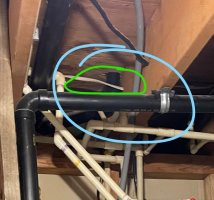I am trying to redo the drain line for my softener. Currently the drain dumps into the sump pit and I would really like to get it into the sewer. The sewer line is in the joists almost directly over the top of the softener. It appears I have about 4" of clearance from the top of the sewer line to the bottom of the upstairs subfloor. Is this enough room to tie an air gap into? Do I really need to add an AAV in as well?
Appreciate your help

Appreciate your help

